3.4 Digestive System Medications
Some of the more common digestive system medications are discussed below. The focus is on the pathologies already mentioned in this chapter because of their prevalence.
Medications for Gastroesophageal Reflux Disease (GERD)
Antacids
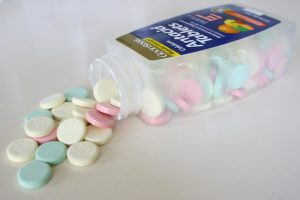
Antacids, as shown in Fig. 3.10, are weak bases and are usually one of the first medications used to treat GERD. They work by neutralizing stomach acid and do so by elevating the pH of the stomach, which weakens the acid and lessens stomach irritation. Antacids are used to reduce the symptoms of heartburn, acid indigestion, and upset stomach. There are many over-the-counter (OTC) medications available for this purpose that contain one of the following active ingredients: calcium carbonate, aluminum hydroxide, and magnesium hydroxide. Antacids come in many different forms, including chewable tablets, capsules, and liquids, all taken orally. Many antacids also contain simethicone, an antiflatulent used for gas relief. Simethicone is described in detail at the end of this page. Some common OTC antacids for GERD are aluminum hydroxide gel, calcium carbonate (Alka-Seltzer, Tums), magnesium hydroxide (Milk of Magnesia, or MOM), Gaviscon, Maalox, Rolaids, and Pepto-Bismol (WebMD, 2022).
H2-Receptor Antagonists, or H2 Blockers
H2-receptor antagonists block histamine’s action at the H2 receptor of the parietal cell, thus reducing the production of hydrochloric acid. H2-receptor antagonists are used to treat GERD, peptic ulcers, erosive esophagitis, and hypersecretory conditions, or as adjunct treatment for the control of upper GI bleeding. The most common routes for H2-receptor antagonists are oral and intravenous. If taken orally, the medication is most effective when taken 15 to 60 minutes before eating or drinking. A common H2-receptor antagonist is famotidine. It is available over the counter (OTC) and is also often prescribed orally or as an intravenous injection in the hospital setting. Other H2-receptor antagonists include cimetidine and ranitidine (Zantac), shown in Fig. 3.11. Cimetidine has a high risk of medication interactions, especially in elderly patients, because of its binding action within the liver, which affects the metabolism of other medications.
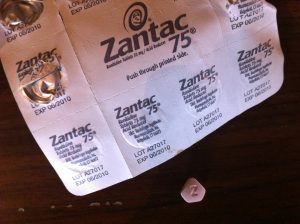
Key Concept
A common suffix in generic H2-receptor antagonist medication names is -tidine.
Examples: ranitidine (Zantac), cimetidine (Tagamet), famotidine (Pepcid)
Some of the medications listed above may include an abbreviation after the brand name that indicates what it is used for; for example, Pepcid AC (acid controller). The table below is a short list of common abbreviations used with H2-blocker medications.
Table 3.3. Common H2-Blocker Abbreviations
| Abbreviation | Meaning |
| AR | acid reducer |
| HB | heartburn |
| AC | acid controller or before meals |
Proton Pump Inhibitors
Proton pump inhibitors (PPIs) work by reducing the amount of stomach acid produced by glands in the stomach lining. They bind to the hydrogen-potassium ATPase enzyme system of the parietal cell, also referred to as the “proton pump” because it pumps hydrogen ions into the stomach. PPIs also inhibit the secretion of hydrochloric acid. A common proton pump inhibitor, pantoprazole (Fig. 3.12) may be administered using various routes, including orally, with a nasogastric tube, or as an intravenous injection in the hospital setting. Other PPIs include esomeprazole, lansoprazole, and omeprazole (Fig. 3.13). PPIs are more powerful than antacids and H2-receptor antagonists. Pantoprazole is used to treat damage from gastroesophageal reflux disease (GERD) in adults and children five years of age and older; it allows the esophagus to heal and prevents further damage. It is also used to treat conditions in which the stomach produces too much acid, such as Zollinger-Ellison syndrome in adults. PPIs may also be given in combination with antibiotics to treat H. pylori infections, a common cause of ulcers.
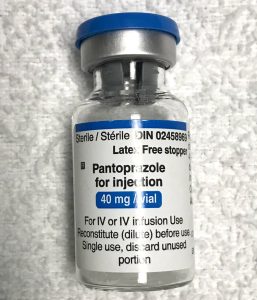
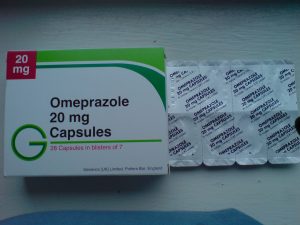
Key Concept
A common suffix for generic proton pump inhibitor medications is -prazole.
Examples: lansoprazole (Prevacid), omeprazole (Prilosec), pantoprazole (Pantoloc), esomeprazole (Nexium)
Medications for Peptic Ulcers
Mucosal Protectants
Mucosal protectants protect the mucosal lining of the stomach from gastric acid. Sucralfate is one example and is used to cover and protect gastrointestinal ulcers, as shown in Fig. 3.14. Sucralfate locally covers the ulcer site in the GI tract and protects it against further attack by acid, pepsin, and bile salts. It is important to administer sucralfate on an empty stomach, two hours after or one hour before meals. Patients with kidney disease or diabetes should use caution when taking sucralfate because of the potential for complications. It is available in tablet form or as a suspension (Mayo Clinic, 2023d).
If a peptic ulcer is caused by H. pylori, the course of treatment will be different and will include antibiotics, a proton pump inhibitor, and possibly an OTC medication, such as Pepto-Bismol, to protect the stomach (Cleveland Clinic, 2021). Fig. 3.15 is an image of the multiple medications, including pantoprazole, metronidazole, amoxicillin, clarithromycin, and Pepto-Bismol, used to treat a peptic ulcer cause by H. pylori.

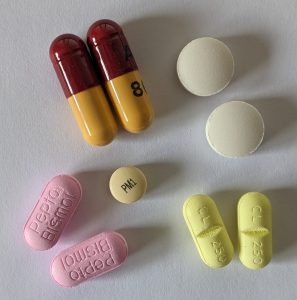
Medications for Constipation
Laxatives and Laxative Classes
There are five categories of laxative medications commonly used to treat constipation: fibre supplements, stool softeners, osmotic agents, lubricants, and stimulants. Fibre supplements and stool softeners can be used daily to prevent constipation, whereas the other laxative categories are used to treat constipation. Table 3.4 below lists each category of laxative, common medications, and how each one works.
Table 3.4. Laxative Categories
| Category | Prototypes | Mechanism of Action |
|---|---|---|
| Fibre supplements | psyllium (Metamucil) | Bulk forming to facilitate the passage of stool through the rectum |
| Stool softeners | docusate (Colace) | Facilitates the movement of water and fats into the stool |
| Osmotic agents | Milk of Magnesia; polyethylene glycol (PEG) 3350 (Miralax) | Causes water to be retained with the stool, increasing the number of bowel movements and softening the stool so it is easier to pass |
| lactulose (Cephulac) | ||
| Lubricants | mineral oil enema (Fleet) | Coats the stool to help seal in water |
| Stimulants | bisacodyl (Dulcolax) | Causes the intestines to contract, inducing stool to move through the colon |
| senna (Senokot) | Causes water to be reabsorbed in the intestines which then promotes movement of the stool within the intestines |
Medications for Nausea and Vomiting
The category of medications used to treat nausea and vomiting is called antiemetics. Antiemetics are prescribed for a number of reasons, including nausea and vomiting associated with surgical recovery from anesthesia and/or opiate analgesia, treatment of motion sickness, severe nausea and vomiting associated with chemotherapy, postoperative nausea and vomiting, and hyperemesis during pregnancy. Several classes of medications fit into this category, including anticholinergics, antihistamines, dopamine antagonists, prokinetics, and serotonin antagonists. Each category is described in further detail below and works on different areas of the body. The following is a short list of common medications used to treat nausea and vomiting from each of these categories:
- scopolamine (Scopace, Maldemar)
- dimenhydrinate (Gravol)
- prochlorperazine (Stemetil)
- metoclopramide (Maxeran)
- ondansetron (Zofran)
Anticholinergics
Scopolamine is an example of an anticholinergic medication that is often used to treat motion sickness or nausea and vomiting associated with surgical recovery from anesthesia and/or opiate analgesia. Anticholinergics block ACh receptors in the brain to prevent nausea-inducing stimuli to the chemoreceptor trigger zone (CTZ) and the vomiting centre (VC). They also dry GI secretions and reduce smooth muscle spasms. Scopolamine comes in the form of transdermal patch and is designed for the continuous release of the drug following application to an area of intact skin on the head, typically behind the ear. The patch is formulated to deliver approximately 1 mg of scopolamine over three days.
Antihistamines
Dimenhydrinate is an example of an antihistamine medication used to treat and prevent nausea and vomiting. It works by competitively blocking H1 receptors, which then prevents the action of histamine on bronchial smooth muscle and capillaries, and gastrointestinal smooth muscle (National Center for Biotechnology Information, 2023). As a result, it decreases gastrointestinal smooth muscle spasms, thereby decreasing nausea and vomiting (National Center for Biotechnology Information, 2023). This medication comes in many forms, including tablets, suppositories, and solutions for injections or intravenous administration.
Dopamine Antagonists
Prochlorperazine is an example of a dopamine antagonist used to treat nausea and vomiting. It can also be used as an antipsychotic medication. Prochlorperazine blocks dopamine in the chemoreceptor trigger zone (CTZ). It also calms the central nervous system and may also block acetylcholine. Prochlorperazine can be administered orally, intramuscularly, rectally, or intravenously. It is contraindicated in children under age two or under 20 pounds.
Prokinetics
Metoclopramide (Fig. 3.16) is an example of a prokinetic medication. It blocks dopamine and may also sensitize tissues to acetylcholine. It is used to promote peristalsis to empty the gastrointestinal tract and therefore reduce nausea. Metoclopramide can be administered orally, intramuscularly, and intravenously.
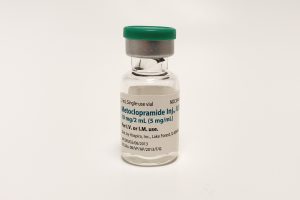
Serotonin Antagonists
Ondansetron, shown in Figs. 3.17 and 3.18, is an example of a serotonin (5HT) antagonist often used to treat severe nausea and vomiting associated with chemotherapy, postoperative nausea and vomiting, and hyperemesis during pregnancy. Ondansetron blocks serotonin receptors in the GI tract, the chemoreceptor trigger zone (CTZ), and the vomiting centre (VC). Ondansetron can be taken orally, sublingually, or as an injection for patients who are too nauseated to tolerate oral medication.
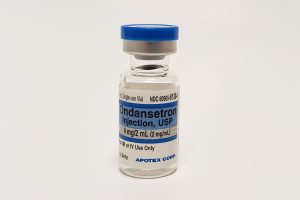
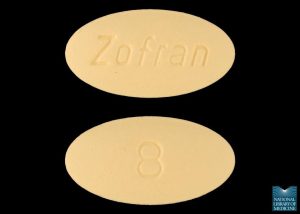
Antiflatulent Medications
Antiflatulent medications are used in the treatment and prevention of excessive amounts of gastrointestinal gas (Drugs.com, 2022). Simethicone is an antiflatulent that is commonly found in other OTC antacids and is used to treat the symptoms of gas, such as uncomfortable or painful pressure, fullness, and bloating. It is also safe for use in infants. Gas commonly occurs in the GI tract because of the digestive processes and swallowing air. Gaseous distension can also occur postoperatively. Simethicone is usually taken four times a day, after meals and at bedtime. It comes in capsules, tablets, and liquid suspensions (Mayo Clinic, 2023c).
Antidiarrheal Medications
Antidiarrheal medications have three common mechanisms of action: adsorbents, which help eliminate toxins or bacteria from the GI tract; antimotility agents, which slow peristalsis; and probiotics, which help restore the normal bacteria found in the lower intestine. Oral rehydration agents may also be used in patients with diarrhea to replace fluid and electrolyte loss, but they do not treat diarrhea. Antibacterial agents may also be used to treat diarrhea caused by specific infections, such as campylobacter or giardia, but they are not routinely needed (WHO, 2017).
Adsorbents
Bismuth subsalicylate (Pepto-Bismol) is an example of an adsorbent (Fig. 3.19). Adsorbent medications work by coating the walls of the GI tract and binding the causative bacteria or toxin for elimination from the GI tract through the stool (Lilley et al., 2014). In addition, adsorbents work by protecting the intestines, easing inflammation, and helping with the symptoms of nausea. This medication is taken orally and comes as a suspension, tablets, chewable tablets, and capsules (Mayo Clinic, 2023a).
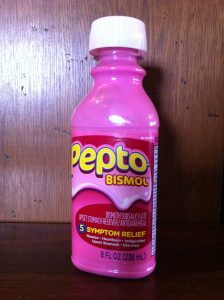
Antimotility Medications
Antimotility medications help treat diarrhea by slowing peristalsis. There are two categories of antimotility medications: anticholinergics and opiate-like medications. Anticholinergic medications work on the smooth muscle of the GI tract to inhibit propulsive motility and decreases gastric acid secretion. A common anticholinergic medication is hyoscyamine.
Loperamide (Fig. 3.20) has an opioid-like chemical structure but causes fewer central nervous system effects. It can be used to treat both acute and chronic diarrhea (Mayo Clinic, 2023b) and works by decreasing the flow of fluids and electrolytes into the bowel and by slowing down the movement of the bowel to decrease the number of bowel movements (WebMD, 2023b). It comes in various forms, including capsules, tablets, liquid solutions, and suspensions (Mayo Clinic, 2023b).
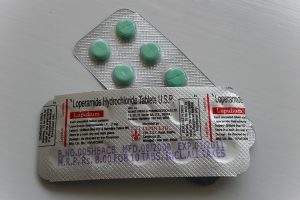

Probiotics
Probiotics (Fig. 3.21) help replenish normal bacterial flora in the gastrointestinal tract. They are used for the prevention and treatment of diarrhea and are often combined with antibiotics to prevent the common associated side effects of diarrhea. An example of a probiotic is lactobacillus.
Table 3.5. Common Digestive System Medications
| Generic Name | Trade Name | Reason for Administering |
| aluminum hydroxide gel | Amphojel | GERD |
| calcium carbonate | Tums | GERD |
| magnesium hydroxide | Milk of Magnesia | GERD, constipation |
| alginate, magnesium | Gaviscon | GERD |
| aluminum hydroxide | Maalox | GERD |
| calcium carbonate | Rolaids | GERD |
| bismuth subsalicylate | Pepto-Bismol | GERD |
| ranitidine | Zantac | GERD |
| cimetidine | Tagamet | GERD |
| famotidine | Pepcid | GERD |
| lansoprazole | Prevacid | GERD |
| omeprazole | Prilosec | GERD |
| pantoprazole | Pantoloc | GERD |
| esomeprazole | Nexium | GERD |
| sucralfate | Sulcrate | Ulcers |
| psyllium | Metamucil | Constipation |
| docusate | Colace | Constipation |
| polyethylene glycol (PEG) | Miralax | Constipation |
| lactulose | Cephulac | Constipation |
| mineral oil enema | Fleet | Constipation |
| bisacodyl | Dulcolax | Constipation |
| senna | Senokot | Constipation |
| scopolamine | Scopace, Maldemar | Nausea related to motion sickness |
| dimenhydrinate | Gravol | Nausea and vomiting |
| prochlorperazine | Stemetil | Nausea and vomiting |
| metoclopramide | Maxeran | Nausea and vomiting |
| ondansetron | Zofran | Nausea and vomiting |
| simethicone | Oval | Antiflatulent |
| hyoscyamine | Levsin | Peptic ulcers, decreases gastric secretions and motility |
| loperamide | Imodium | Diarrhea |
(WebMD, 2023b)
Attribution
Unless otherwise indicated, material on this page has been adapted from the following resource:
Ernstmeyer, K., & Christman, E. (Eds.). (2020). Nursing pharmacology. Chippewa Valley Technical College. https://wtcs.pressbooks.pub/pharmacology/, licensed under CC BY 4.0
References
Cleveland Clinic. (2021). H. pylori infection. https://my.clevelandclinic.org/health/diseases/21463-h-pylori-infection#:~:text=H.%20pylori%2Dcaused%20ulcers%20are,(Flagyl%C2%AE)%20and%20tetracycline
Drugs.com. (2022). Antigas antiflatulent ultra strength. https://www.drugs.com/otc/119157/antigas-antiflatulent-ultra-strength.html
Lilley, L. L., Rainforth Collins, S., & Snyder, J. S. (2014). Pharmacology and the nursing process (7th ed.) (pp. 782–862). Elsevier.
Mayo Clinic. (2023a). Bismuth subsalicylate (oral route). https://www.mayoclinic.org/drugs-supplements/bismuth-subsalicylate-oral-route/description/drg-20068521
Mayo Clinic (2023b). Loperamide (oral route). https://www.mayoclinic.org/drugs-supplements/loperamide-oral-route/description/drg-20064573
Mayo Clinic (2023c). Simethicone (oral route). https://www.mayoclinic.org/drugs-supplements/simethicone-oral-route/description/drg-20068838
Mayo Clinic (2023d). Sucralfate (oral route). https://www.mayoclinic.org/drugs-supplements/sucralfate-oral-route/description/drg-20066120
National Center for Biotechnology Information. (2023). PubChem compound summary: Dimenhydrinate. https://pubchem.ncbi.nlm.nih.gov/compound/Dimenhydrinate
WebMD. (2023b). Drugs & medications A–Z. https://www.webmd.com/drugs/2/index
WebMD. (2023a). Loperamide – Uses, side effects, and more. https://www.webmd.com/drugs/2/drug-4789-4025/loperamide-oral/loperamide-oral/details
WebMD. (2022). Which OTC meds treat heartburn? https://www.webmd.com/heartburn-gerd/guide/treating-heartburn-over-counter-medicine
World Health Organization (WHO). (2017, May 2). Diarrhoeal disease. https://www.who.int/en/news-room/fact-sheets/detail/diarrhoeal-disease
Image Credits (images are listed in order of appearance)
Antacid-L478 by Midnightcomm, CC BY-SA 3.0
Zantac Pill and Pill Pack by ParentingPatch, CC BY-SA 3.0
PantoIV by James Heilman, MD, CC BY-SA 3.0
Omeprazole 20mg by Siufaiho, Public domain
Benign gastric ulcer 1 by Ed Uthman, MD, Public domain
H.pyloriTx by Doc James, CC BY-SA 4.0
Metoclopramide by Intropin (Mark Oniffrey), CC BY-SA 4.0
Ondansetron 3 by Intropin (Mark Oniffrey), CC BY-SA 4.0
000817lg Zofran 8 MG Oral Tablet by National Library of Medicine, NIH, Public domain
PeptoBismol Bottle by ParentingPatch, CC BY-SA 3.0
Loperamide2mg by Kristoferb, CC BY-SA 3.0
Biogaia Lactobacillus Reuteri Product by openfoodfacts.org, CC BY-SA 3.0
pertaining to within the vein
a type of bacteria that can cause peptic ulcers
medications used to treat nausea and vomiting
injected into the muscle
the contraction and relaxation of muscles that move in a wave down a tube, for example, in the intestines
under the tongue

